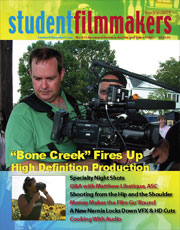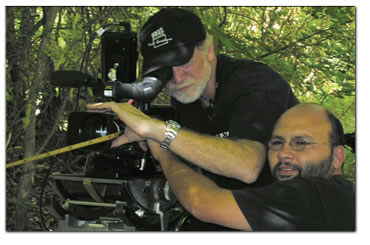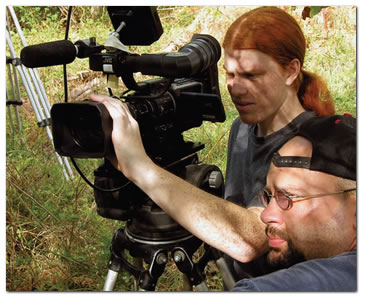HOW-TO, Techniques, & Best Practices Channel
| Feature "Bone Creek" Fires Up High Def Production: Challenges Are New Format, New Workflow, and Achieving the 'Film Look' By Staff posted Nov 8, 2009, 07:02 |
Check out this article in the print edition of StudentFilmmakers Magazine, January 2008. More production stills featured in the print edition. Click here to get a copy and to subscribe >>
 Feature "Bone Creek" Fires Up High Def Production
Feature "Bone Creek" Fires Up High Def Production
Challenge: New Format, New Workflow, and Achieving the 'Film Look'
by Michael Corbett
| Continued on Next Page> | Page 1 | 2 | 3 |
I am a self-described “film chauvinist.” Film is kinetic and visceral. You load the camera with film, shoot it, process it, cut it, glue it together, and then, watch the outcome projected on a wall by a noisy clattering projection machine.
I started my career shooting 1200 feet of 16mm film every work day on local news stories, running it through an industrial style ME 4 processor, editing it, and watching it go out over the air on the 6 o’clock news.
Shooting news I got so comfortable with Kodak ASA 125 tungsten reversal film that to this day I can estimate the ƒ stop in most common shooting situations within a stop. The organic emulsions on the film from the people with the yellow box were user-friendly and robust. The film gave us a good 3 to 5 ƒ stops of acceptable exposure range for broadcast TV and rich highly saturated colors.
Instructor and director of photography, Michael Corbett and student camera assistant Ronnie Chavis set a focus mark on the JVC GY-HD100 camera on the Piedmont Community College (PCC) class project production of the feature film “Bone Creek.”

When so-called portable video cameras came on the scene, they were big, clunky, prone to technical problems, and captured images in the American television NTSC format (never the same color twice). They used very slow lenses and needed lots of light.
As I graduated into television commercial and feature film work, video was looked upon with disdain by my peers and me. NTSC video was an inferior medium we were forced to transfer our beautiful film images to for mass distribution.
Fast-forward forty years. We have shot three feature length narrative films in the last 5 years as class projects on 16mm film with our collaborator, Emily Edwards from the University of North Carolina at Greensboro. This year she insisted that we use High Definition video for our feature project Corbett“Bone Creek.” I argued, resisted, and drug my feet but finally gave in.
Left to right, students Robert Corbett and Ronnie Chavis shooting second unit with the JVC GY-HD100 camera on the Piedmont Community College (PCC) class project production of the feature film “Bone Creek.”

I was afraid of this new format. Not only was this video, but it was tapeless with a whole new workflow far removed from manipulating real pieces of film that you can hold up to the light to see the image. The images are now all stored as ones and zeros on P2 cards or portable hard disk drives.
I am sure we are way into overkill, but we have all of the media from “Bone Creek” archived on Emily’s computer, on the instructor’s workstation in our editing lab, on the portable Firewire drive we use to transfer the files from Yanceyville to Greensboro, on my computer at home and on a RAID drive we purchased specifically to archive this project set up to mirror the files on two separate disk drives. I am still anxious that our work on this show is secure.
We launched into pre-production on “Bone Creek” not knowing what camera we would shoot with. We had been holding off on committing to the purchase of an HD camera until the second-generation HD cameras had enough time in the field to be reviewed. We finally committed to the purchase of a Panasonic AG-HVX200. Unfortunately, we were not able to order it in time to arrive for our first day of principal photography.
| Continued on Next Page> | Page 1 | 2 | 3 |